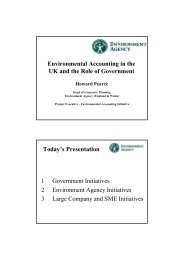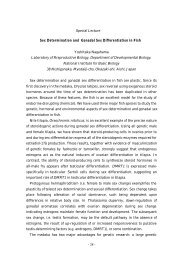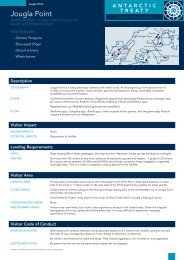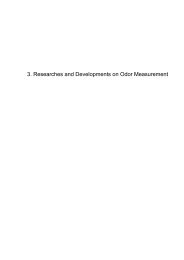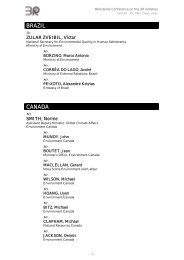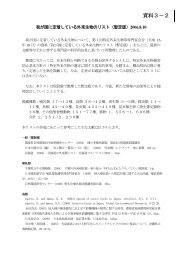Presentation Material [PDF 4494KB]
Presentation Material [PDF 4494KB]
Presentation Material [PDF 4494KB]
You also want an ePaper? Increase the reach of your titles
YUMPU automatically turns print PDFs into web optimized ePapers that Google loves.
Can ‘natural’ adaptation save coral atoll<br />
islands from destruction by<br />
climate change and sea-level rise?<br />
Roger McLean<br />
School of Physical, Environmental and Mathematical Sciences<br />
The University of New South Wales – Canberra<br />
ACT, Australia 2610<br />
International Conference on Climate Change and Coral<br />
Reef Conservation at Okinawa Institute of Science and<br />
Technology Graduate University, hosted by the Ministry of<br />
Environment of Japan 29 th -30 th June, 2013.
Maldives<br />
Archipelago<br />
Problem:<br />
Small island nations at the front-line of impacts from climate<br />
change & sea-level rise. Atoll island nations most vulnerable:<br />
Maldives, Chagos, Tuvalu, Kiribati, Marshall Islands, Tokelau<br />
Why?<br />
•Accelerated coastal erosion/land loss (Bruun rule)<br />
• Increased inundation / sea flooding<br />
• Sea water intrusion into fresh-water lens<br />
• Higher reach of king tides / storm surges<br />
•Destruction of settlements/ infrastructure<br />
[And ultimately island abandonment/out migration?]<br />
Question:<br />
How can atoll islands reduce the potential impacts through<br />
adaptation? Can ‘natural’ adaptation save atoll islands from<br />
destruction by climate change and sea-level rise?<br />
Answer:<br />
Yes, where it is possible to maintain or develop the dynamic<br />
two-way linkages between coral reef ecosystems and atoll<br />
islands. Reefs need to be healthy and productive and the<br />
islands capable of persisting or building either upwards or<br />
outwards.
What are coral atoll islands? Why are they so vulnerable?<br />
Atolls are ring-shaped coral reefs that partly or wholly surround a lagoon;<br />
atoll Islands - located on reef rim or patch reefs within lagoon.<br />
Atoll islands are:<br />
• wave built accumulations of bioclastic sediment-skeletal sands and /or coral<br />
rubble sourced from adjacent reef or lagoon;<br />
• geologically very young having accumulated in the last few thousand years;<br />
• small size and low elevation (
And yet some atoll islands have high population<br />
densities notably on the ‘capital’ islands<br />
Male (Maldives))<br />
DUD<br />
Majuro<br />
(Marshall Islands)<br />
Fongafale<br />
Funafuti<br />
(Tuvalu)<br />
Betio<br />
South<br />
Tarawa<br />
(Kiribati)
1989<br />
24 years ago<br />
“The alternatives before us can be<br />
summarized as follows: accept what is<br />
going to happen; try coastal<br />
defences; elevate the surface area<br />
of islands; retreat inland; migrate!”<br />
- President Gayoom, Maldives, 16 th Nov 1989<br />
Tuvalu Prime Minister warned his<br />
nation was in danger of<br />
disappearing under rising sea<br />
levels. “If this continues, there<br />
will be no Tuvalu at all.”<br />
- Bikenbeu Paeniu, April 1989
Adaptation: Three definitions<br />
1. Autonomous adaptation: “adaptation that does<br />
not constitute a conscious response to climate stimuli<br />
but is triggered by ecological changes in natural<br />
systems...” (IPCC, WG2, 2007)<br />
2. Planned adaptation: “adaptation that is the result<br />
of a deliberate policy decision...” (IPCC, WG2, 2007)<br />
3. ‘Natural’ adaptation = Planned + Autonomous<br />
“a deliberate policy decision to permit, and not<br />
impede, ‘natural’ ecological changes in reef systems<br />
and geomorphological changes in atoll island<br />
systems as a consequence of climate change and<br />
sea-level rise” (as used here)
Theoretical Adaptations in Atoll Island Nations<br />
PROTECT<br />
Most commonly used individually,<br />
community and government<br />
ACCOMMODATE<br />
Planned accommodation<br />
rarely used though many<br />
local alternatives<br />
RETREAT<br />
Retreat inland hardly an option<br />
given width of most atoll islands.<br />
Retreat to less vulnerable islands?<br />
Retreat through migration?
Protect<br />
Male (Maldives)<br />
Note seawall here<br />
Attack on Male under Bellagio<br />
1631<br />
Male today: Seawalls and tetrapod breakwaters<br />
around most of the island
Natural linkages between coral reef as source of<br />
skeletal sand and coral rubble (the sediment ‘factory’)<br />
and atoll island as a sediment sink<br />
1. Moat marks extent of the island<br />
‘footprint’ that represents the<br />
dynamic zone linking reef and island<br />
2. Changing plan shape of island<br />
and profile surveys showing erosion<br />
and accretion across the island<br />
‘footprint’<br />
Coral<br />
reef<br />
Island<br />
Sediment sink<br />
Moat<br />
Sediment<br />
factory
What can happen to reef islands with sea–level rise if the<br />
reef is healthy & there is no barrier stopping the sediment<br />
pathway between reef > island, and island > reef?<br />
Example 1: December 2004 Tsunami Impact in Maldives<br />
Tide gauge<br />
at Huluhule<br />
Male<br />
Tsunami waves tide gauge<br />
records and level over island<br />
Plan surveys of uninhabited<br />
Islands before and after tsunami
Beach accretion and on<br />
island fresh sand sheet<br />
deposition<br />
Net result: increase in<br />
island area & elevation
Number of Daily<br />
Observations<br />
1600<br />
1650<br />
1700<br />
1750<br />
1800<br />
1850<br />
1900<br />
1950<br />
2000<br />
2050<br />
2100<br />
2150<br />
2200<br />
Example 2:<br />
Short-term<br />
sea-level rise<br />
January to July<br />
2007 in<br />
Maldives<br />
Frequency Distribution of Daily Sea Level at Hulhule,<br />
Male, Maldives 1989-2008<br />
2500<br />
2000<br />
1500<br />
1000<br />
500<br />
0<br />
0 0 3 24 244 90920601982832 178 30 4 0<br />
n = 6788<br />
skew = 0.038<br />
mean = 1898 mm<br />
min = 1687 mm<br />
max = 2129 mm<br />
Tide Gauge Level in mm<br />
Two highest levels ever: 23 June 2007 (2129 mm) 24 June 2007 (2110)<br />
Maximum hourly values 2340 mm (23 rd ) and 2293 mm (24 th )
Fresh deposition<br />
on island surface;<br />
new sand sheets and<br />
sand lobes<br />
2007 deposition Prior Island surface<br />
Fresh biogenic sediment<br />
Note: 2007 deposit<br />
overlies tsunami<br />
sediment<br />
2007 deposition<br />
Post-tsunami<br />
litter layer<br />
Result: increase in<br />
island elevation<br />
Tsunami<br />
Deposition<br />
2004
Example 3: Hurricane Bebe,<br />
Funafuti Atoll, October 1972
Post-hurricane<br />
Bebe Surveys,<br />
Funafuti atoll<br />
Profile 3<br />
1972-2004<br />
1973<br />
island<br />
2004<br />
1983<br />
1981<br />
1979<br />
1978<br />
1976<br />
1973<br />
1972<br />
ocean<br />
side<br />
breccia<br />
reef flat<br />
Distance from datum (m)<br />
Need time to establish<br />
new dynamic equilibrium
Key messages<br />
1. Atoll islands are part of coral reef ecosystems with intimate and<br />
dynamic linkages between reef>island and island>reef.<br />
2. Atoll islands may be sustainable provided<br />
• they are surrounded by healthy and productive reefs;<br />
• the sediment pathways between reefs and islands are not<br />
obstructed; and<br />
• they are given time to adjust (‘naturally adapt’) to the new<br />
and ongoing changes in climate, sea level and other drivers.<br />
3. It is possible to plan for autonomous adaptation of atoll reef and<br />
island systems.<br />
4. If this is done some reefs and islands in atoll archipelagos<br />
could be developed and maintained to serve as a safety valve if<br />
conditions on other islands deteriorate to such an extent that<br />
further occupation becomes unsustainable.
Surging tidal waves flood Male:<br />
July 22nd, 2010 (Maldives News)
Acknowledgements and thanks to:<br />
Governments of Maldives and Tuvalu for permission &<br />
support to undertake surveys over the years ;<br />
Local staff and many colleagues and collaborators who I<br />
have worked with in the field;<br />
The Ministry of Environment of Japan for inviting me to<br />
attend the International Conference on Climate Change and<br />
Coral reef Conservation at Okinawa Institue of Science and<br />
Technology Graduate University, 29 th -30 th June, 2013.<br />
THANK YOU


![Presentation Material [PDF 4494KB]](https://img.yumpu.com/22029884/1/500x640/presentation-material-pdf-4494kb.jpg)
![Presentation Material [PDF 1664KB]](https://img.yumpu.com/23394763/1/190x132/presentation-material-pdf-1664kb.jpg?quality=85)
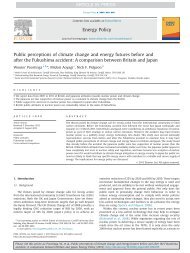
![List of Participants[PDF 221KB]](https://img.yumpu.com/22029974/1/184x260/list-of-participantspdf-221kb.jpg?quality=85)

